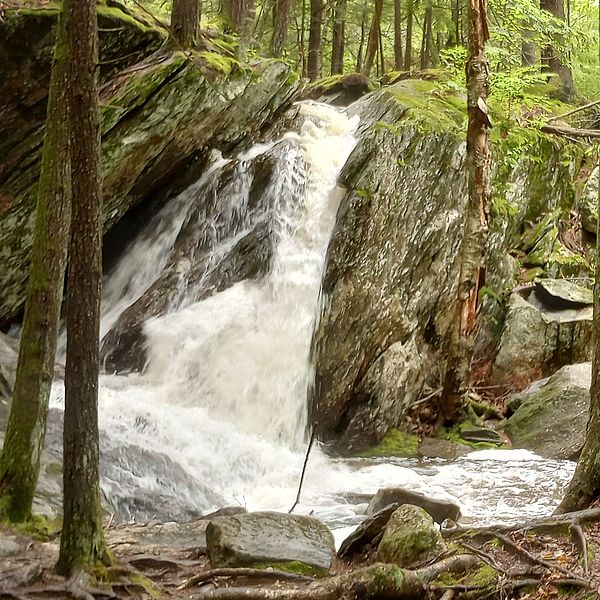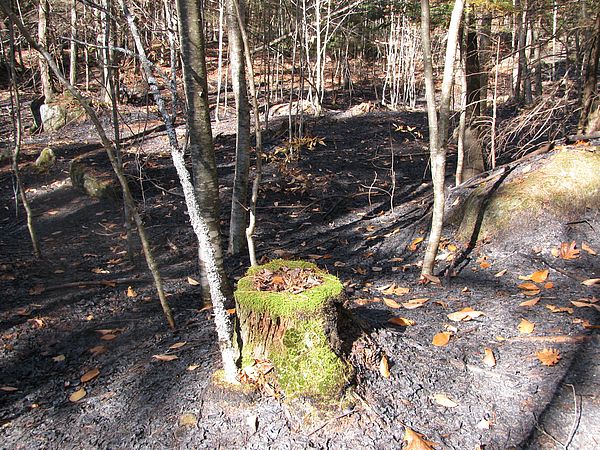By Janine Marr
The Monadnock Conservancy’s Calhoun Family Forest is a nature-lover’s paradise. Located in Gilsum just north of Bear's Den Natural Area, it has hills and streams, woods and trails, wildlife and wildflowers. Best of all, the forest has a lot of history packed into a few hundred acres. Recently, I walked the Porcupine Falls Loop Trail, an easy walk at less than a mile in length. There, I experienced the early history of Gilsum and witnessed the resilience of the forest.
My hike began at the parking area at the end of White Brook Road. The brook was named after the White family, who lived in the red house at the corner of what is now Route 10 (that same house later became home to the Calhoun family). As I crossed the bridge over White Brook, I entered a forest filled with hemlock, pine, hardwoods, and a rich agricultural history.
The trail to Porcupine Falls follows the babbling White Brook. I passed a forested area, where a ground fire occurred in October of 2013. The fire burned leaves and ferns beneath the hemlocks and young beech trees. At the time, the fallen branches were as black as the charred soil, and the only green at the ground layer was the moss on stumps and rocks. Sometimes, when a fire does not burn too deeply into the soil, it exposes seeds that sprout, including trees, shrubs, and invasive species. At the Calhoun Forest, the burned area has long since grown in with ferns and hardwood saplings, creating a younger patch of forest.
Farther down the trail was a huge white pine tree with multiple trunks branching above the ground, sometimes called a bull, wolf, or cabbage pine. When the tree was young, a white pine weevil damaged the growing tip, or leader, so the top whorl of horizontal branches each became a new leader, turning upward.
What struck me about this white pine was its size. It measured over three feet in diameter, suggesting that it was well over 100 years old, dating back to the turn of the last century or even before, when the sheep pasture formerly on this site was abandoned and young pines invaded. The pine has a healthy crown, demonstrating its resilience—it survived the white pine blister rust epidemic of the early 1900s, the hurricanes of 1938 and 2011, the forest fire of 2013, and a long history of logging designed to improve the overall health of the forest.
Next, I approached a series of stone steps that led me to Porcupine Falls, named by the Calhoun Family after the creatures that inhabited the many small caves nearby. I stood on the bridge crossing White Brook, listening to the falling water. The falls are surrounded by rock faces and birch, maple, and hemlock trees, resembling a secret wood that time forgot.
I continued along the trail through rich woods dominated by sugar maple and white ash, soon joining a discontinued section of White Brook Road bounded by stone walls and sugar maple trees over two feet in diameter. This section of trail led to an open space once used as a log landing. This was also the area where the last house on White Brook Road stood over a century ago. The cellar hole in the woods no longer supports a wood-frame house; instead, it nurtures trees and shrubs amidst the old foundation stones.
As I left the remains of the old homestead and walked the trail back to the parking area, I felt privileged to have experienced a short and easy hike to such a picturesque treasure in the small NH town of Gilsum, a treasure that has proven resilient to many changes brought by farming, logging, natural disturbances, and time.
The Porcupine Falls Loop Trail is accessible during the summer and fall from the White Brook Road trailhead. During the winter months, visitors can hike to the falls on the longer trail that starts at the Route 10 parking area just north of White Brook Road.

